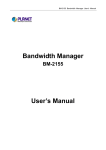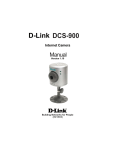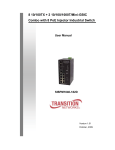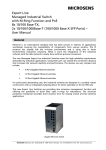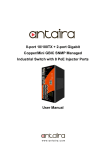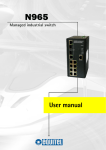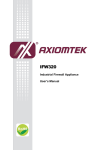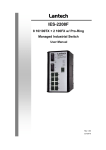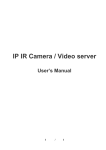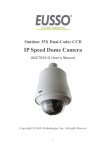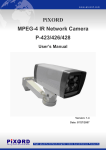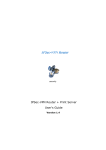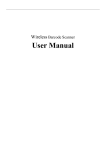Download Bandwidth Manager User`s Manual
Transcript
BM-2010A / BM-2100 Bandwidth Manager User’s Manual Bandwidth Manager BM-2010A / BM-2100 User’s Manual BM-2010A / BM-2100 Bandwidth Manager User’s Manual Copyright Copyright (C) 2004 PLANET Technology Corp. All rights reserved. The products and programs described in this User ’s Manual are licensed products of PLANET Technology, This User ’s Manual contains proprietary information protected by copyright, and this User ’s Manual and all accompanying hardware, software, and documentation are copyrighted. No part of this User’s Manual may be copied, photocopied, reproduced, translated, or reduced to any electronic medium or machine-readable form by any means by electronic or mechanical. Including photocopying, recording, or information storage and retrieval systems, for any purpose other than the purchaser's personal use, and without the prior express written permission of PLANET Technology. Disclaimer PLANET Technology does not warrant that the hardware will work properly in all environments and applications, and makes no warranty and representation, either implied or expressed, with respect to the quality, performance, merchantability, or fitness for a particular purpose. PLANET has made every effort to ensure that this User’s Manual is accurate; PLANET disclaims liability for any inaccuracies or omissions that may have occurred. Information in this User’s Manual is subject to change without notice and does not represent a commitment on the part of PLANET. PLANET assumes no responsibility for any inaccuracies that may be contained in this User ’s Manual. PLANET makes no commitment to update or keep current the information in this User ’s Manual, and reserves the right to make improvements to this User’s Manual and/or to the products described in this User’s Manual, at any time without notice. If you find information in this manual that is incorrect, misleading, or incomplete, we would appreciate your comments and suggestions. CE mark Warning This is a class A device, In a domestic environment, this product may cause radio interference, in which case the user may be required to take adequate measures. Trademarks The PLANET logo is a trademark of PLANET Technology. This documentation may refer to numerous hardware and software products by their trade names. In most, if not all cases, these designations are claimed as trademarks or registered trademarks by their respective companies. Customer Service For information on customer service and support for the Bandwidth Manager, please refer to the following Website URL : http://www.planet.com.tw Before contacting customer service, please take a moment to gather the following information : ♦ Bandwidth Manager serial number and MAC address ♦ Any error messages that displayed when the problem occurred ♦ Any software running when the problem occurred ♦ Steps you took to resolve the problem on your own Revision User’s Manual for PLANET BM-2010A / BM-2100 Model: BM-2010A / BM-2100 Rev: 2.0 (April, 2004) Part No. EM-BMV2 BM-2010A / BM-2100 Bandwidth Manager User’s Manual Table of Contents CHAPTER 1:INTRODUCTION................................................................................................................................... 1 1.1 FEATURES ............................................................................................................................................................... 1 1.2 PACKAGE CONTENTS .............................................................................................................................................. 2 1.3 BANDWIDTH MANAGER FRONT VIEW ..................................................................................................................... 3 1.4 BANDWIDTH MANAGER REAR PANEL ..................................................................................................................... 5 1.5 SPECIFICATION ........................................................................................................................................................ 7 CHAPTER 2:HARDWARE INSTALLATION ............................................................................................................ 8 2.1 INSTALLATION REQUIREMENTS ............................................................................................................................... 8 INSTALL BANDWIDTH MANAGER TO YOUR NETWORK.................................................................................... 8 CHAPTER 3:GETTING STARTED .......................................................................................................................... 10 3.1 INITIAL SETUP BY LCD PANEL .............................................................................................................................. 10 3.2 LOGGING IN AS ADMINISTRATOR ........................................................................................................................... 11 CHAPTER 4:WEB CONFIGURATION .................................................................................................................... 12 4.1 SYSTEM SETTINGS................................................................................................................................................ 12 4.1.1 Information................................................................................................................................................... 12 4.1.2 Network........................................................................................................................................................ 13 4.1.3 Bandwidth.................................................................................................................................................... 13 4.1.4 Date/Time .................................................................................................................................................... 14 4.1.5 Host .............................................................................................................................................................. 14 4.1.6 Service ......................................................................................................................................................... 16 4.1.7 SNMP........................................................................................................................................................... 17 4.1.8 Backup/Restore .......................................................................................................................................... 18 4.1.9 Firmware Upgrade ..................................................................................................................................... 19 4.1.10 Account ...................................................................................................................................................... 20 4.1.11 Reboot........................................................................................................................................................ 20 4.1.12 Logout ........................................................................................................................................................ 21 4.2 POLICY EDITOR ..................................................................................................................................................... 22 4.2.1 Policy Editor ................................................................................................................................................ 22 4.2.2 Protection .................................................................................................................................................... 24 4.2.3 IP/MAC Binding Setting............................................................................................................................. 25 4.2.4 IP/MAC Table .............................................................................................................................................. 25 4.2.5 Discover IP/MAC ........................................................................................................................................ 26 4.2.6 Export / Import ............................................................................................................................................ 27 4.2.7 Access Control Setting .............................................................................................................................. 28 BM-2010A / BM-2100 Bandwidth Manager User’s Manual 4.2.8 Access List .................................................................................................................................................. 28 4.3 REPORT ................................................................................................................................................................. 30 4.3.1 Connection .................................................................................................................................................. 30 4.3.2 Internal Host................................................................................................................................................ 31 4.3.3 External Host............................................................................................................................................... 31 4.3.4 Service ......................................................................................................................................................... 31 4.3.5 Top 10 Internal Host................................................................................................................................... 32 4.3.6 Top 10 External Host.................................................................................................................................. 32 4.3.7 Top 10 Service ............................................................................................................................................ 33 4.3.8 Bandwidth Policy ........................................................................................................................................ 33 4.3.9 Customize.................................................................................................................................................... 34 4.3.10 IP Discovery - Text List ............................................................................................................................ 35 4.3.11 IP Discovery - Graph List ........................................................................................................................ 35 4.3.12 Log – Export Log ...................................................................................................................................... 36 4.3.13 Log – To Analyzer..................................................................................................................................... 38 4.3.14 Email Account ........................................................................................................................................... 38 4.3.15 Alert Event ................................................................................................................................................. 39 CHAPTER 5:USING BANDWIDTH ANALYZER ................................................................................................... 40 5.1 INSTALL MYSQL: .................................................................................................................................................. 41 5.2 INSTALL MYSQL ODBC: ...................................................................................................................................... 44 5.3 INSTALL BANDWIDTH ANALYZER: .......................................................................................................................... 46 5.4 USING BANDWIDTH ANALYZER ............................................................................................................................. 50 BM-2010A / BM-2100 Bandwidth Manager User’s Manual Chapter 1:Introduction Business-critical and time-sensitive applications such as VoIP or transaction processing need guaranteed bandwidth. PLANET’s new 10Mbps and 100Mbps Bandwidth Managers, the BM-2010A and BM-2100, offer network administrators an easy yet powerful means to allocate network resources based on business priorities, and to shape, analyze and control bandwidth usage. Expensive WAN resources are more effectively utilized, avoiding the need for costly upgrades while still meeting business priorities. The PLANET BM-2010A and BM-2100 are simple to install, with two 10/100Mbps Ethernet port for connecting to the local network and the WAN router respectively. A 16x2 character LCD panel makes installation and maintenance easier and more efficient. For bandwidth management, packets can be classified based on IP address, IP subnet and TCP/UDP port number. The device has more than 20 of the most common protocols such as H.323, Oracle, HTTP, FTP, etc. for ease of definition; the administrator can then define policies to ensure committed and maximum bandwidth levels for inbound / outbound traffic in each class. The administrator can also define three priority levels for each policy to ensure that high priority packets receive the maximum available bandwidth. In addition, each policy can have a schedule defined for when the policy is activated or inactivated in increments of 5 minutes. The BM-2010A and BM-2100 also enable administrators to effectively measure traffic on the network and provide comprehensive graphical reports about how bandwidth is being used. The administrator can view each internal host’s inbound and outbound traffic or each network service’s inbound and outbound traffic. The BM-2010A and BM-2100 also provide a graphical report for either the top ten internal hosts or services that generate traffic. A free utility, Bandwidth Analyzer, is also provided to help you make further analysis of the bandwidth usage. This reporting system helps administrators quickly understand and reallocate bandwidth usage to an optimized level and make best use of the limited and expensive Wide-area network bandwidth. For uninterrupted Internet access, the BM-2010A and BM-2100 also provide an in-box bypass function to keep your Internet service available. 1.1 Features ♦ Desktop placement or 19-inch rack-mount size with two 10/100Mbps Fast Ethernet port for true 10Mbps or 100Mbps inbound and outbound throughput ♦ LCD panel for initial setup and network information display ♦ Remote configuration through standard web browser with SSL security ♦ Supports SNMP to simplify management ♦ Transparent operation requires no changes to existing network structure ♦ Traffic classification based on IP, IP range/subnet and TCP/UDP port range ♦ Configurable guaranteed and maximum bandwidth with three levels of priorities ♦ Assigns daily and weekly access schedules to each individual policy ♦ Real time traffic monitoring with graphical bandwidth usage display ♦ Policy bandwidth usage report and customization of bandwidth usage reports ♦ A free utility, Bandwidth Analyzer, helps with further bandwidth analysis ♦ All user connections can be recorded and uploaded to an ftp sever for billing or analysis ♦ Simple backup and restore of configuration files with full SSL protection ♦ Basic firewall functions with access control by IP or MAC ♦ IP/MAC discover function finds all hosts on the LAN ♦ In-box bypass architecture ensures uninterrupted traffic flow even in the event of device failure -1- BM-2010A / BM-2100 Bandwidth Manager User’s Manual 1.2 Package Contents The following items should be included: ♦ Bandwidth Manager ♦ Power Cord ♦ Quick Installation Guide ♦ User’s Manual and utility CD ♦ Rack mounting kit (BM-2100 only) ♦ Cat.5 cross-over cable If any of the contents are missing or damaged, please contact your dealer or distributor immediately. -2- BM-2010A / BM-2100 Bandwidth Manager User’s Manual 1.3 Bandwidth Manager Front View - Front View of BM-2100: LAN W AN 100 ACT LN K 100 ACT LN K ESC Bandwidth Manager PWR ENTER BM-2100 LCD Panel LED Panel LCD Panel: Used to make IP settings, view IP settings, reboot system, show service information, reset password and reset all configuration. It also show the average bandwidth usage for past 10 seconds when not in configuration mode. Check section “Initial Setup by LCD panel” for detail on IP settings. The following table shows the button function. Button (Enter) (ESC) (▲) (▼) Function Used to select or confirm the selection Used to cancel the selection or back to previous manual Change to previous option or increase the number. Press longer to increase the number by 10. Change to next option or decrease the number. Press longer to decrease the number by 10. LED Panel: Used to show the system and connection status. The following table show the connection LED definition. LED PWR - Status Lit Green Meaning Indicates the device is receiving power STATUS Lit Red Indicates the device is reading data from momery LNK Lit Green Link is established on LAN or WAN port ACT Blink Green Packets are transmitting or receiving on LAN or WAN port 100 Lit Green Indicates the link operate on 100Mbps Off Indicates the link operate on 10Mbps Front View of BM-2010A: Bandwidth Manager BM-2010A ESC ENTER LAN WAN POWER 10/100 STATUS LNK/ACT LED Panel LCD Panel -3- BM-2010A / BM-2100 Bandwidth Manager User’s Manual LCD Panel: Used to make IP settings, view IP settings, reboot system, show service information, reset password and reset all configuration. It also show the average bandwidth usage for past 10 seconds when not in configuration mode. Check section “Initial Setup by LCD panel” for detail on IP settings. The following table shows the button function. Button (Enter) (ESC) Function Used to select or confirm the selection Used to cancel the selection or back to previous manual Change to previous option or increase the number. Press longer to increase the number by 10. Change to next option or decrease the number. Press longer to decrease the number by 10. (▲) (▼) LED Panel: Used to show the system and connection status. The following table show the connection LED definition. LED Status Meaning PWR Lit Green Indicates the device is receiving power STATUS Lit Red Indicates the device is reading data from memory LAN/ WAN LNK/ Lit Green Link is established on LAN or WAN port ACT Blink Green Packets are transmitting or receiving on LAN or WAN port 10/ 100 Lit Amber Indicates the link operate on 100Mbps Off Indicates the link operate on 10Mbps -4- BM-2010A / BM-2100 Bandwidth Manager User’s Manual 1.4 Bandwidth Manager Rear Panel - Rear View of BM-2100: Console 19200, N, 8, 1 AC line : 100~240V AC 50/60Hz Console Port LAN Port WAN Port Port Power On / Off Function Power On/Off Switch LAN Port WAN Port Console This is where you will connect the AC power cord. 100~240VAC is allowed. You can turn on/off this device by the switch when the power cord is connected This is where you will connect the RJ-45 line to your local switch or device. This port is MDI interface This is where you will connect the RJ-45 line to your router or ISP. This port is MDI interface This port is reserved for manufacturer use only - Rear View of BM-2010A 100~240V AC WAN LAN CONSOLE DIP 115200, N, 8, 1 RESET 50/60 Hz Power WAN Port LAN Port Console DIP Port Power On/Off Switch LAN Port WAN Port CONSOLE RESET Function This is where you will connect the AC power cord. 100~240VAC is allowed. You can turn on/off this device by the switch when the power cord is connected This is where you will connect the RJ-45 line to your local switch or device. This is where you will connect the RJ-45 line to your router or ISP. This port is reserved for manufacturer use only Press this button to reset the settings back to factory default -5- On / Off Reset BM-2010A / BM-2100 Bandwidth Manager User’s Manual Off: Beeper enabled (default) On: Beeper disabled Off: By-pass function enabled (default) 2 On: By-pass function disabled 3,4 Not used 1 DIP -6- BM-2010A / BM-2100 Bandwidth Manager User’s Manual 1.5 Specification Product Model Hardware Connections Button LCD Panel System LED 10Mbps and 100Mbps Bandwidth Manager BM-2010A BM-2100 Power Operating Environment 100~240 VAC, 50~60Hz Temperature: 5~40°C Relative Humidity: 20%~90% 255 x 170 x 44 mm 431 x 271 x 44 mm FCC, CE Mark Dimension W x D x H Regulatory Software Maximum Bandwidth Maximum Host catalog + Service Catalog + Policy Maximum concurrent session Management Traffic Classification Bandwidth Allocation Real-Time Report Advanced Report Firewall Other Functions 2 x 10/100Base-TX Hardware Reset 16x2 characters LCD System: Power, Status Network: ACT/LNK, 10/100 System: PWR, STATUS Network: ACT, LNK, 100 for LAN and WAN ports 10Mbps 256 100Mbps 1024 10000 65535 Web with SSL protect, SNMP, LCD panel IP, IP subnet, TCP/UDP port Hierarchy of policy rules with In/Out traffic management Guaranteed and maximum bandwidth Scheduled in unit of 5 minutes 3 Priorities Number of Connections Internal Host In/Out Traffic Service In/Out Traffic Top 10 Host Top 10 Service All Policies Bandwidth Usage Customized Bandwidth Usage Report Bandwidth Analyzer for advanced analysis Upload each user’s connection data to FTP sever for billing or other analysis Deny SYN / UDP / ICMP flood, deny port scan Access control to limit user’s access rights based on IP or TCP/UDP port Discard per user connection based on IP or MAC Firmware upgradeable through web NTP support Configuration backup and restore through web In-box bypass -7- BM-2010A / BM-2100 Bandwidth Manager User’s Manual Chapter 2:Hardware Installation 2.1 Installation Requirements Before installing the Bandwidth Manager, make sure your network meets the following requirements. - Mechanical Requirements The Bandwidth Manager is to be installed between your router and local area network. The Bandwidth Manager can be placed on the table or rack. Locate the unit near the power outlet. - Electrical Requirements The Bandwidth Manager is powered from 100/240 VAC. A standard IEC connector is used for the power cable. Follow all applicable electrical codes. Frame ground should be tied to a common grounding point using #18AWG cable. NOTE: The Bandwidth Manager is a power-required device, it means, the Bandwidth Manager will not work until it is powered. If your networked PCs will need to transmit data all the time, please consider use an UPS (Uninterrupted Power Supply) for your Bandwidth Manager. It will prevent you from network data loss. In some area, installing a surge suppression device may also help to protect your Bandwidth Manager from being damaged by unregulated surge or current to the Bandwidth Manager. - Network Requirements In order for Bandwidth Manager to manage traffic, the traffic must pass through Bandwidth Manager at a useful point in a network. In most situations, the bandwidth manager should be placed behind the Internet connection router. This deployment allows the network administers to control all bandwidth based on business priorities and give business-critical and time-sensitive applications guarantee bandwidth and higher priority. Business-critical applications can receive maximum performance while other less urgent traffic is still available on remaining bandwidth. Bandwidth Manager also provides comprehensive reporting functions to help monitor network and bandwidth usage and allow adjustment of the bandwidth management policies accordingly. The Bandwidth Manager provides two 10/100Base-TX port for connecting to WAN (external) and LAN (internal) side. The network ports are both MDI (media dependent interface) port. Please use straight Category 5 UTP Ethernet cable to connect the network port to switch, hub or other devices with MDI-X interface and use cross-over cable to connect the network port to router, DSL/Cable modem or other devices with MDI interface. 2.2 Install Bandwidth Manager to Your Network - Choose an Installation Site Select a suitable place on the network to install the Bandwidth Manager. - Connect LAN Cables Use standard LAN cables to connect your LAN side Switch or Hub to the LAN ports on Bandwidth Manager. Both 10Base-T and 100Base-T connections can be used. The LAN and WAN port of bandwidth manager support Auto-Negotiation to connect with best speed and duplex mode. The LAN port of Bandwidth -8- BM-2010A / BM-2100 Bandwidth Manager User’s Manual Manager is MDI port. hub. Thus, you can just use straight network to connect the LAN port to your switch or - Connect WAN Cable Connect the router, DSL or Cable modem to the WAN port on Bandwidth Manager. The LAN and WAN port of Bandwidth Manager are both MDI port. Thus, in some case, you may need to use cross-over cable to connect your router, DSL or cable modem. - Power Up Connect the supplied power cord to Bandwidth Manager and use the power switch that in rear panel to turn on the Bandwidth Manager. Use only the power cord provided. Using a different one may cause hardware damage. NOTE: Once you power on the Bandwidth Manager, it will start to beep indicated it is on by-pass mode. This is normal and when the system stop to beep, the system booting is completed. - Check the LEDs The PWR LED should be ON. The STATUS LED should flash for about 1 to 2 minutes, then turn Off. This LED will also flash when is reading data from the memory. Both the WAN and LAN’s LNK LED should be on. If one of the LED is off, please check the network connection. In some case, you may need to use cross-over cable to connect the LAN or WAN port to your networks. For more information, refer to Section 1.3 Bandwidth Manager Front View. -9- BM-2010A / BM-2100 Bandwidth Manager User’s Manual Chapter 3:Getting Started This chapter explains how to setup your computer to be a client to manage the Bandwidth Manager. 3.1 Initial Setup by LCD Panel 1. Press (ENTER) button to enter Select menu. 2. Choose Setup Network and press (ENTER) button to enter IP setup process. SELECT: Setup Network 3. Set the Bandwidth Manager IP address: IP Address: 192.168.1.251 Please press (▲) or (▼) button to edit the Bandwidth Manager IP address. Press (ENTER) button to edit next number. After editing all the number, press (ENTER) button to start the Network mask configuration. NOTE: You can press (▲) or (▼) longer for it the number to change in unit of 10. 4. Set the Bandwidth Manager subnet mask: Netmask Address: 255.255.255.0 Please press ((▲) or (▼) button to edit the Bandwidth Manager IP address. Press (ENTER) button to edit next number. After editing all the number, press (ENTER) button to start the Gateway address configuration. 5. Set the Bandwidth Manager Gateway address: Gateway Address: 192.168.1.254 Please press (▲) or (▼) button to edit the Bandwidth Manager IP address. Press (ENTER) button to edit next number. After editing all the number, press (ENTER) button to save the configuration. 6. Confirm and Save Configuration: Save Config? Y(Enter) N(ESC) If the configuration is Ok, please press (ENTER) button to save. Otherwise, press (ESC) button to go back to SELECT Menu. 7. After you press (ENTER), the following message is shown: 。 Setup Network Save OK.... Now the new IP settings is active and you can start on web management of the Bandwidth Manager. - 10 - BM-2010A / BM-2100 Bandwidth Manager User’s Manual 3.2 Logging in as Administrator Now you can communicate with Bandwidth Manager by web browser. Open the web browser and type https://192.168.0.250:8889. Please note that “8889” is the port number of Bandwidth Manager management interface, “https” here is to invoke the SSL of you web browser. You must key in user name and password to enter its web management interface. The default user name is “admin” without password. Then, you will enter Bandwidth Manager’s Configuration Menu. - 11 - BM-2010A / BM-2100 Bandwidth Manager User’s Manual Chapter 4:Web Configuration This chapter introduces how to configure the Bandwidth Manager to effectively control your bandwidth usage. On the top of the Web interface, there is three major menu of the bandwidth manager: System Settings: The basic system configurations Policy Editor: The policy that will be used to manage the bandwidth Report: The reporting system of the bandwidth manager base on the system settings and pre-defined policy The bandwidth manager will need the three parameters before it operates the bandwidth control: Host, (illustrated in section 4.1.6), Services (illustrated in section 4.1.7) and Policy, (illustrated in section 4.2). However, some of the configurations are also required. Please refer to the related section for the details. 4.1 System Settings System settings menu contains three categories: “General” allows you to configure basic network parameters, Internet connection bandwidth and date/time. “Catalog” allows you to define host and services information which is needed for policy editor. “Admin” contains options to setup SNMP, backup / restore settings, upgrade firmware, etc. 4.1.1 Information This section shows information about the Bandwidth Manager - 12 - BM-2010A / BM-2100 Bandwidth Manager User’s Manual 4.1.2 Network You can setup Bandwidth Manager network settings in this section. ♦ Host Name: Please assign a name that is easy to remember for Bandwidth Manager. ♦ Domain Name: Your local network domain name. ♦ DNS Server: Your ISP’s DNS server IP or your DNS server IP. ♦ IP Address: Please assign an IP that is not in use by other device for Bandwidth Manager. The default IP address of Bandwidth Manager is 192.168.0.250. This IP address can be on different subnet from other internal hosts that you want to manage. For example, the Bandwidth Manager’s IP can be 192.168.0.250 and you can use it to manage internal hosts with IP in 10.x.x.x subnet. ♦ Network Mask: Your local network subnet mask. ♦ Default Gateway: Your local network default gateway. For example, 192.168.0.254. ♦ Save: Press save button to save all these configurations. Note: For example, 255.255.255.0. If you have modified the IP address to a different IP subnet, you need to also modify the IP address of management client’s IP address settings. 4.1.3 Bandwidth Please enter your network bandwidth here. exceed this value. The sum of guaranteed bandwidth for all policies should not ♦ Inbound Bandwidth: Input the downstream speed of your Internet connection (WAN port). value is form 1 to 2048 in units of kbps. ♦ Outbound Bandwidth: Input the upstream speed of your Internet connection (WAN port). value is form 1 to 2048 in units of kbps. ♦ Save: Press save button to save all these configurations. The valid The valid BM-2010A allows up to 10Mbps (10240kbps) and BM-2100 allows up to 100Mbps (102400kbps) inbound/outbound bandwidth in both directions of its WAN port. Please be aware of the bandwidth that your Internet services provider provided. It is not necessary to configure Inbound and outbound bandwidth in the same values. Asymmetric bandwidth like 1.5Mbps (1544Kbs) downstream, 384Kbps upstream ADSL is - 13 - BM-2010A / BM-2100 Bandwidth Manager User’s Manual allowed. 4.1.4 Date/Time The Date/Time menu contains commands for setting Bandwidth Manager's time and date required for correctly record the bandwidth usage time. User can directly input the date and time or specify the NTP server for the device to synchronize with time-server. Click on “Date/Time” in the system settings menu bar and the Date/Time screen will appear as illustrated below: ♦ Date: Input the year and select the Date from the pull-down list respectively. ♦ Time: Select the Time from the pull-down list respectively. ♦ NTP Server: Local NTP (Network time protocol) server IP or DNS name. If you want to manually configure the date and time, left this field blank. Note: Please find below NTP server web address for your reference to set the time-server. http://www.eecis.udel.edu/~mills/ntp/clock1a.htm http://www.eecis.udel.edu/~mills/ntp/clock2a.htm ♦ Time Zone: System administrator must select the time zone for the region. ♦ Save: Press save button to save all these configurations. If you have input a NTP server IP address or DNS name, the Bandwidth Manager will try to inquire the current time and update the Date and Time field. ♦ Renew All Report: When new configured time is earlier than old time settings, you need to click “Renew All Report” or the report function can not work properly. The Date/Time information will be used in the reporting system (refer to section 4.3). If your Bandwidth Manager can reach to the Internet, you can find the nearest NTP server in the Internet for your Bandwidth Manager that should provide the accurate date and time for the bandwidth manager. NOTE: 1. Clicking Renew All Report will clear all statistic data recorded on the memory of Bandwidth Manager. 2. If NTP server is configured, the configured Date and Time will not work. 4.1.5 Host Bandwidth Manager can control the bandwidth usage via host IP address. You must define local and/or remote user’s IP address that you want to manage to the host catalog. This host catalog is useful on defining policy. The total number of host catalog, service catalog and policies cannot exceed 512 for BM-2010A and 1024 for BM-2100. The Host Catalog page lists all the defined hosts with host name, IP address and location. - 14 - On the top of the BM-2010A / BM-2100 Bandwidth Manager User’s Manual host table, the following buttons are available: ♦ New - Create new host catalog. ♦ Prev - Go to previous page. ♦ 1, 2, … - First, second, … page. ♦ Next - Next page. On the Action field of each host name, the following two buttons are provided: - Modify the host catalog - Delete the host catalog After clicking “New” or Modify button, the following host configuration page will be shown: ♦ Host Name: The name of specified IP address or a range of IP address. With it, you can easily tell the bandwidth usage through this meaningful name. For example, a name like “Web_server” to a dedicated IP, or “Acct_Group” for the IP range of accounting department. ♦ IP Address: IP or IP range of this host. You can input by single IP address, IP range, IP subnet or mix of about formats and divided by comma. For example, 192.168.0.1, 192.168.0.5, for the two devices using (IP address 1 and 5); 192.168.0.20-30 (for the range of IP address from 20 to 30), and 192.168.0.128/28 (for IP address from 128 to 143). ♦ Location: If the host’s position is on the WAN side of Bandwidth Manager in the network, please choose external. If the host’s position is on the LAN side of Bandwidth Manager, please choose internal. - 15 - BM-2010A / BM-2100 Bandwidth Manager User’s Manual ♦ Monitor: Enable or disable to monitor the traffic flow with this IP or IP range and show on the report function. ♦ Description: Additional description of this host(s). ♦ Save/Cancel: Press save button to save above configurations and Cancel button to discard your configurations. After clicking Save or Cancel button, the Host Catalog page will be shown again. To edit the host(s) you have configured, please click Modify button on the Action field. To remove the host(s) you have configured, please click Delete button on the Action field. 4.1.6 Service The Service Catalog contains all the popular services that you may want to manage. The total number of host catalog, service catalog and policies can not exceed 512 for BM-2010A and 1024 for BM-2100. The bandwidth Manager have contained 22 predefine services. For other Internet services, however, you can direct click on New to add the services or click on Modify icon to modify and remove by click on the delete icon. ♦ New - Create new service. ♦ Prev - Go to previous page. ♦ 1, 2, … - First, second, … page. ♦ Next - Next page. On the Action field of each service name, the following two buttons are provided: - Modify the Service catalog - Delete the Service catalog After clicking “New” or Modify button, the following service configuration page will be shown. - 16 - BM-2010A / BM-2100 Bandwidth Manager User’s Manual ♦ Name: Name of this service. For example, www, http or telnet. ♦ Protocol: Choose which kind of protocol this service use. For example, Telnet is using TCP; voice data transmission like PLANET VoIP gateway, is using UDP. ♦ Monitor: Enable or disable to monitor this type of traffic flow and show on the report function. ♦ Port Number: enter the port number this service use. For example, Telnet will use port 23, http will use port 80, PLANET VoIP gateway is using 30000 to 30100 by default. ♦ Description: Additional description of this service. ♦ Save/Cancel: Press save button to save above configurations and Cancel button to discard your configurations. After clicking Save or Cancel button, the Service Catalog page will be shown again. To edit the service you have configured, please click Modify button on the Action field. To remove the service you have configured, please click Delete button on the Action field. 4.1.7 SNMP Use the SNMP Configuration screen to display and modify parameters for the Simple Network Management Protocol (SNMP). The device includes an on-board SNMP agent which monitors the status of its hardware, as well as the traffic passing through it. A computer attached to the network, called a Network Management Station (NMS), can be used to access this information. Access rights to the agent are controlled by community string. To communicate with the device, the NMS must first submit a valid community string for authentication. - 17 - BM-2010A / BM-2100 Bandwidth Manager User’s Manual ♦ Enable SNMP: ♦ Community Strings: A community entry authorized for management access. Check this box to enable the SNMP function. The network management station must use same string to read the SNMP data from the device. ♦ System Location: Specifies the area or location where the device resides. ♦ Contact Information: Contact person for the device. ♦ Save: Press save button to save all these configurations. 4.1.8 Backup/Restore You can easily backup and restore the current configuration of Bandwidth Manager. ♦ Backup: Press “Start” button on the Config Download row to download the configuration file of Bandwidth Manager to your local client side. The following page will then be shown. Click “Save” to save the configuration file. Note: It is strongly recommended to backup your file configuration file whenever you have complete the configurations. - 18 - BM-2010A / BM-2100 Bandwidth Manager User’s Manual ♦ Restore: Press “Browse…” button to select the configuration file you have saved before. Then press “Start” button to start upload configuration file to Bandwidth Manager. After confirm backup date and network settings, press “Restore” button to start restore all of the configurations to Bandwidth Manager. After restore is completed, a “Restore complete“ window prompts. Click “OK” to continue. 4.1.9 Firmware Upgrade PLANET will announce new patch or firmware on the website for users. You can download the latest firmware from the website and use this screen to upgrade. - 19 - BM-2010A / BM-2100 Bandwidth Manager User’s Manual 4.1.10 Account You can change the user name and password when you log in on this window. ♦ Old Name: The old name you use to log in Bandwidth Manager ♦ New Name: The new name that you want to change. ♦ Old Password: Enter old password that you use before. ♦ New Password: The new password that you want to change. ♦ New Password Again: Confirm new password again. ♦ Save: Press “Save” button to save all the configurations. After save is completed, the following window is prompted, click “OK” to continue. Note: For safety reason, it is strongly recommended to change the default password and store the password in a safe place. 4.1.11 Reboot You can reboot Bandwidth Manager from web and by Reset button on the rear side of this device. Press “Reboot” button to reboot the Bandwidth Manager, while reboot is processing, this info prompt. - 20 - BM-2010A / BM-2100 Bandwidth Manager User’s Manual 4.1.12 Logout You can logout the management interface after finishing your configuration. - 21 - BM-2010A / BM-2100 Bandwidth Manager User’s Manual 4.2 Policy Editor You can setup all the control policies, make IP/MAC binding for security and control access right in this section. 4.2.1 Policy Editor Here will list all the policies that you have made. The total number of host catalog, service catalog and policies can not exceed 512 for BM-2010A and 1024 for BM-2100. The following functions are provided on this page: ♦ New - Create new policy ♦ Prev - Go to previous page. ♦ 1, 2, … - First, second, … page. ♦ Next - Next page. - Modify the existing policy - Delete the policy - Schedule the time when the policy will be enabled. Press “New” or Modify button, the policy configuration page will be shown as the following. ♦ Order: Policies processing sequence. When the Bandwidth Manager receives a packet, it will find the packet’s Internal Host, External Host and Service and check which policy the packet applies. Order 1 policy will be the first policy to check and so on. When the Bandwidth Manager find a policy fit to the - 22 - BM-2010A / BM-2100 Bandwidth Manager User’s Manual packet, it will stop the checking and apply the guarantee bandwidth, burst bandwidth and priority to the packet. Thus, always put mission-critical traffic policy in the front to get higher performance. ♦ Internal Host: The internal host that you want to manage. host catalog. ♦ External Host: The destination host that you want to manage. You have to first define the external host on host catalog. You can build an external host if the Bandwidth Manager is deployed in a LAN to LAN (VPN, Wireless, G.SHDSL, etc) network environment. ♦ Service: The service that you want to manage. ♦ Guarantee: Assign guaranteed bandwidth in kbps to this policy. This is the minimum bandwidth that the policy guarantees. The sum of all guarantee bandwidth should not exceed the inbound and outbound bandwidth settings on chapter 4.1.3. ♦ Burst: This policy’s maximum bandwidth may be used. can use. ♦ Priority: The packet’s priority on this policy. When packets compete un-guaranteed bandwidth, packets on higher priority policy always process first. ♦ Enable: Enable or disable this policy. ♦ Save/Cancel: Press “Save” button to save above configurations and “Cancel” button to discard your configurations. You may use You have to first define the internal host on The services must be defined on the service catalog. This is the maximum bandwidth that the policy button on policy list to schedule when each policy will be enabled. ♦ Start time: Time to start policy activation. ♦ End time: Time to terminate policy activation. ♦ Week: Days in a week that you want QoS policy to take effect. - 23 - BM-2010A / BM-2100 Bandwidth Manager User’s Manual ♦ Enable: Enable or disable this schedule. ♦ Save/Cancel: Press “Save” button to save all the configurations and “Cancel” button to discard your configurations. 4.2.2 Protection The Bandwidth Manager provides extended capabilities for filtering out any malicious attacks based on TCP, UDP, or ICMP protocols. This greatly improves the security of your bandwidth, and guarantees that such attacks will not disrupt the normal operation of your systems. While filtering out detected malicious traffic, your network will be able to operate normally. ♦ Deny SYN Flood: TCP SYN Flood is one kind of attack that an attacker makes connection requests aimed at the victim device with packets with unreachable source addresses. The device is not able to complete the connection requests and, as a result, the device wastes all of its network resources, resulting in shutting down a device. By defining a SYN attack threshold, the bandwidth manager allows only the certain number of packets with unreachable source addresses each second. ♦ UDP Flood Attack: UDP is a connectionless protocol and it does not require any connection setup procedure to transfer data. An UDP Flood Attack is possible when an attacker sends a UDP packet to a random port on the victim device. When the victim device receives an UDP packet, it will determine what application is waiting on the destination port. When it realizes that there is no application that is waiting on the port, it will generate an ICMP packet of destination unreachable to the forged source address. If enough UDP packets are delivered to ports on victim, the device will go down. By defining a UDP flood threshold, the bandwidth manager allows only the certain number of destination unreachable UDP packets each second. ♦ ICMP Flood Attack: An ICMP flood is usually accomplished by broadcasting either a bunch of pings or UDP packets. The idea is, to send so much data to your system, that it slows you down so much that you're disconnected from IRC due to a ping timeout. By defining a ICMP flood attack threshold, the bandwidth manager allows only the certain number of ICMP packets each second. ♦ Deny Port Scan: Most attackers will first scan all port of the victim to know which services are running and then determined how to attack. Deny port scan will make hacker much hard to attack your internal LAN. ♦ Circumventing Path MTU Discovery with MSS Clamping(for ADSL, cable, PPPoE): An Ethernet packet provides maximum 1460 bytes payload. However, not all parts of the Internet support full 1460 bytes of payload per packet. It is therefore necessary to try and find the largest packet that will 'fit', in order to optimize a connection. This process is called 'Path MTU Discovery', where MTU stands for 'Maximum Transfer Unit.' However, Path MTU Discovery is not always working. MSS (Maximum - 24 - BM-2010A / BM-2100 Bandwidth Manager User’s Manual Segment Size) is another way to set the maximum packet size. This is a field in the TCP Options part of a SYN packet. By enable MSS clamping, the bandwidth manager calculates the proper MSS for your link and tell the remote side unequivocally 'do not ever try to send me packets bigger than this value'. Enable this function if your Internet connection is ADSL or cable modem and you meet connection problem with your ISP. 4.2.3 IP/MAC Binding Setting IP/MAC Binding allow you to bind IP and MAC to allow or block only certain IP/MAC or MAC for passing through the bandwidth manager. The IP/MAC binding table can be build by importing from text file or discovering by the bandwidth manager. The following functions are provided on this page: ♦ Binding Function: Enable or disable binding function. ♦ Binding Mode: There are two options on binding mode – Block the traffic when not defined or not match in the IP/MAC table. Select this option if you only want to allow the Internet access of defined and enabled IP/MAC addresses. Allow the traffic when not defined or match in the IP/MAC table. Select this option if you only want to block the Internet access of defined and enabled IP/MAC addresses. 4.2.4 IP/MAC Table Here will list all the defined IP/MAC binding table that you have built. The following functions and information are provided on this page: ♦ New - Create new IP/MAC binding. ♦ Delete All - Delete all the IP/MACbinding table ♦ Prev - Go to previous page. ♦ 1, 2, … - First, second, … page. ♦ Next - Next page. On the Action field of each IP address, the following two buttons are provided: - Modify the IP/MAC binding - 25 - BM-2010A / BM-2100 Bandwidth Manager User’s Manual - Delete the IP/MAC binding Press “New” or modify button, the IP/MAC Table configuration page will be shown as the following. ♦ MAC Address: The MAC address of the host in format of xx:xx:xx:xx:xx:xx. ♦ IP Address: The IP address of the host in format of xxx.xxx.xxx.xxx. address only, input 0.0.0.0 here. ♦ Enable: Enable or Disable the IP/MAC binding. block blocking mode. If you want to specify the MAC Only enabled IP/MAC binding is applied to the allow or 4.2.5 Discover IP/MAC The Discover IP/MAC function help you to find all the IP/MAC binding on your local network. functions and information are provided on this page: The following ♦ IP Subnet: Input a class C subnet for the Bandwidth Manager to find all host and their MAC address on the subnet. ♦ Ignore Defined: Select Yes if you want to ignore the defined IP/MAC binding. However, if only MAC address or IP address is defined on the IP/MAC table, the bandwidth manager will still show the IP/MAC binding on the result window. ♦ Start Discover: Click this button to start the discovery process. After clicking the “Start Discover”, a warning message is shown to prompt for waiting a moment and don’t press stop button of browser. A screen similar to the following is then shown for all IP/MAC address the bandwidth manager found on the IP subnet you specify. The following functions and information are provided on this page: - 26 - BM-2010A / BM-2100 Bandwidth Manager User’s Manual ♦ Clear All: Unselect al the IP/MAC binding. ♦ Select All: Select all the IP/MAC binding. ♦ Import: Import the selected IP/MAC binding to the IP/MAC Table. ♦ Cancel: Discard the discover result and go back to Discover IP/MAC page. On the table, each item has 3 fields: ♦ Select: Check this box to import to the IP/MAC table after clicking Import button. ♦ IP Address: IP address the bandwidth manager discovers. If there is already an IP address defined on the IP/MAC table, a * will be shown after the address to denote it is defined on the IP/MAC table. ♦ MAC Address: IP address the bandwidth manager discovers. If there is already a MAC address defined on the IP/MAC table, a * will be shown after the address to denote it is defined on the IP/MAC table. 4.2.6 Export / Import This page allows you to export the IP/MAC table or import IP/MAC binding from a text file. ♦ Export IP/MAC file: export the IP/MAC data to a file named ipmac.dump in text format. ♦ Import IP/MAC file: Click “Browse…” to select the IP/MAC table file you want to import and then click “Start” to import. Each item in the IP/MAC Table file has 3 fields and use “space” to divide each field: Field 1: IP address Field 2: MAC address Field 3: Enabled or disabled, 1 for enabled, 0 for disabled. An example is as the following: 192.168.0.1 00:30:4F:18:CB:D4 1 192.168.0.2 00:30:4F:23:45:64 1 192.168.0.3 00:30:4F:AB:CD:EF 0 - 27 - BM-2010A / BM-2100 Bandwidth Manager User’s Manual 4.2.7 Access Control Setting Access Control function allows you to control the access right of packets based on their IP address and TCP/UDP port. In Access Control setting, you can enable or disable the access control function and choose its access control mode. ♦ Access Control Function: Enable or disable access control function. If it is enabled, the access control checking will be processed first before bandwidth policy checking. ♦ Access Control Mode: There are two options on access control mode – Allow the traffic when deny rules aren’t defined in the Access List. You can choose allow or deny on the policy field on the Access List. Select this option if you only want to block the Internet access of defined IP addresses and TCP/UDP port with deny policy. Deny the traffic when allow rule aren’t defined in the Access List. Select this option if you only want to allow the Internet access of defined IP addresses and TCP/UDP port with allow policy. 4.2.8 Access List Access List allow you to define the access right based on traffic’s source and destination IP address, and TCP/UDP port (service). The following functions and information are provided on this page: ♦ New - Create new service. ♦ Prev - Go to previous page. ♦ 1, 2, … - First, second, … page. ♦ Next - Next page. ♦ Action - On the Action field of each service name, the following two buttons are provided: - Modify the Access list - Delete the Access list - 28 - BM-2010A / BM-2100 Bandwidth Manager User’s Manual Press “New” or Modify button, the access list configuration page will be shown as the following. ♦ Order: Access List processing sequence. When the Bandwidth Manager receives a packet, it will find the packet’s Source Host, Destination Host and Service and check which Access List the packet applies. Order 1 will be the first list to check and so on. When the Bandwidth Manager find a list fit to the packet, it will stop the checking and accept or deny the packet. Thus, always put mission-critical traffic list in the front to get higher performance. ♦ Source Host: The source host that you want to control. You have to first define the source host on host catalog. This is the host(s) which originates the network service request. It can be on LAN(internal) or WAN(external) side. ♦ Destination Host: The destination host that you want to control. You have to first define the destination host on host catalog. This is the host(s) which receives the network service request. It can be on LAN(internal) or WAN(external) side. ♦ Service: The service that you want to control. ♦ Policy: Accept or deny this access list. ♦ Save/Cancel: Press “Save” button to save above configurations and “Cancel” button to discard your configurations. The services must be defined on the service catalog. - 29 - BM-2010A / BM-2100 Bandwidth Manager User’s Manual 4.3 Report PLANET Bandwidth Manager can monitor all the inbound and outbound packets and automatically categorize to provide versatile reports. These reports help you to analyze the traffic flowing through your Bandwidth Manager and aid you in determining the optimum configuration for your system. 4.3.1 Connection This report shows all the connections passed Bandwidth Manager and you can choose several periods that you want it to display. - 30 - BM-2010A / BM-2100 Bandwidth Manager User’s Manual 4.3.2 Internal Host This report shows the bandwidth usage rate of each internal host. And you can choose several kinds of period that you want it to display. The graph report shows both inbound and outbound traffic. 4.3.3 External Host This report shows the bandwidth usage rate of each external host. And you can choose several kinds of period that you want it to display. The graph report shows both inbound and outbound traffic. 4.3.4 Service This report shows the bandwidth usage rate that each service used. And you can choose several kinds of period that you want it to display. The graph report shows both inbound and outbound traffic. - 31 - BM-2010A / BM-2100 Bandwidth Manager User’s Manual 4.3.5 Top 10 Internal Host This report shows top 10 bandwidth usage of internal hosts. And you can choose several kinds of period that you want it to display. Press button to view graph report of specified internal host. The graph report shows both inbound and outbound traffic. 4.3.6 Top 10 External Host This report shows top 10 bandwidth usage of external hosts. And you can choose several kinds of period that you want it to display. - 32 - BM-2010A / BM-2100 Bandwidth Manager User’s Manual Press button to view graph report of specified internal host. The graph report shows both inbound and outbound traffic. 4.3.7 Top 10 Service This report shows top 10 bandwidth usage of services. And you can choose several kinds of period that you want it to display. Press button to view graph report of specified service. outbound traffic. 4.3.8 Bandwidth Policy - 33 - The graph report shows both inbound and BM-2010A / BM-2100 Bandwidth Manager User’s Manual You can choose each policy that you want to view. And you can choose several kinds of period that you want it to display. The graph report shows both inbound and outbound traffic. 4.3.9 Customize This function offers system administrator to easily collect network bandwidth usage rate information to report. The Bandwidth Manager will record the traffic of all the defined host catalog, service catalog and policy and save the following data in a specified time period: ♦ The average bandwidth usage per minute for past 12 hours ♦ The average bandwidth usage per 10 minutes for past 60 hours ♦ The average bandwidth usage per hour for past 10 days ♦ The average bandwidth usage per day for past 360 days (1 year) Thus, when you use customize to show the bandwidth usage statistic, please make sure you do not use a time period that Bandwidth Manager does not record. ♦ Name: Customized report title. ♦ Type: Type of report. ♦ Period: Choose several periods that you wants to do a routine record in our report ♦ End Time: Stop to record network bandwidth usage rate in this report. ♦ Disabled no data: If there is no data in some item. You may decide that enable or disable these items Three options provided: Internal host / service / bandwidth policy. display on the report. Press “OK” button to generate a report you have customized - 34 - BM-2010A / BM-2100 Bandwidth Manager User’s Manual The following is a part of customized report as a sample. 4.3.10 IP Discovery - Text List This function lists all the internal IP addresses which have pass through Bandwidth Manager and their upload and download data for past one day. This offer you an easily way for you to know which host use most bandwidth and how many bandwidth it have used for past one day. It also helps you to find the hidden node(s) on your network and take adequate action. Press “Renew to count” button that reset the data to zero and start to count all the internal IP bandwidth usage again. You can also press “Upload Transfer (byte)” button to sort by upload transfer rate and press “Download Transfer (byte)” button to sort by download transfer rate. 4.3.11 IP Discovery - Graph List - 35 - BM-2010A / BM-2100 Bandwidth Manager User’s Manual This function provide a graph view all the internal IP addresses which have pass through Bandwidth Manager and their upload and download data and you can choose several periods that you want it to display. 4.3.12 Log – Export Log This function allows you to send all the session statistics to a FTP server. The log data which compressed with tgz is sent to FTP server every 5 minutes. This data is suitable for you to make your own analysis and even billing. The following parameters are required: ♦ Export Function: Enable or disable the export function. ♦ Server Type: Choose the server type as FTP or FTPS. secure than FTP. FTPS is FTP with SSL security which is more Please make sure your FTP server also support FTPS before choose FTPS. ♦ IP Address: The IP address of the FTP server. ♦ Port Number: The TCP port number used for FTP communication. The default port number for FTP is 21. ♦ − Remote Dir: The directory used to store the log data. Please make sure you have created this directory on the FTP server before make test. If this field is left blank, the log will export to the home directory configured on your FTP server. For example, C:\FTP. If you want to export the log to C:\FTP\BM directory, you need to create the directory first and input BM on this field. ♦ User Name: The user name used to login to FTP server. ♦ Password: The password used to login to FTP server. ♦ Save: Press “Save” button to save above configurations. ♦ Test: Test the connection status to FTP server. If the server is on-line and the remote directory, user - 36 - BM-2010A / BM-2100 Bandwidth Manager User’s Manual name and password are all correct, the Bandwidth Manager will upload a file named “test_upload” to the remote directory and a small window will pop-up with message of “Server is ready”. Otherwise, it will show “Can not connect to server”. Once you click “Save”, the Bandwidth Manager will start to export the logo data to FTP server every 5 minutes. The file name format of log data is “year-month-day-hour-minute.txt.gz”. For example, 2003-05-21-19-15.txt.gz. The minute represent the start time of the log data. Each log file contains many connection session for the 5 minutes. Host1 Host2 192.168.001.040 192.168.002.137 192.168.002.137 192.168.001.203 The data format is as the following with an example: Protocol Port1 Port2 6 6 139 3982 4109 22 Received Bytes 1 Received Bytes 2 Received Packets 1 Received Packets 2 184023 52932 5164128 190218 2461 330 3729 355 First Packet Time Last Packet Time 01:40:02.9531 01:45:01.9304 01:40:25.7275 01:45:02.1453 First Packet Host Last Packet Host 2 2 2 1 ♦ Host1: Host 1 IP address, eg: 192.168.001.040 ♦ Host2: Host 2 IP address, eg: 192.168.002.137 ♦ Protocol: Network connection protocol, 1=icmp, 6=tcp, 17=udp, 0= other non-TCP/IP packets. ♦ Port1: Port number used by host 1, eg: 139 ♦ Port2: Port number used by host 2, eg: 3982 ♦ Received Bytes 1: Total number of received data by host 1 in unit of bytes ♦ Received Bytes 2: Total number of received data by host 2 in unit of bytes ♦ Received Packets 1: Total number of received packets by host 1 ♦ Received Packets 2: Total number of received packets by host 2 ♦ First Packet Time: Time the first packet pass through the Bandwidth Manager. session start. This is the time the The time format is HH:MM:SS.SSSS which HH is hours, MM is minutes, and SS.SSSS is seconds with precision up to 1/10,000 seconds. ♦ Last Packet Time: Time the last packet pass through the Bandwidth Manager. This is the time the session complete. The time format is HH:MM:SS.SSSS which HH is hours, MM is minutes, and SS.SSSS is seconds with precision up to 1/10,000 seconds. - 37 - BM-2010A / BM-2100 Bandwidth Manager User’s Manual ♦ First Packet Host: 1 mean Host 1 send the first packet, i.e., host 1 start the session. 2 mean Host 2 send the first packet, i.e., host 2 start the session. ♦ Last Packet Host: 1 mean Host 1 send the last packet, i.e., host 1 complete the session. 2 mean Host 2 send the last packet, i.e., host 2 complete the session. 4.3.13 Log – To Analyzer This function allows you to export the connection data to Bandwidth Analyzer for further analysis. know each IP’s bandwidth usage and service usage ratio from this free utility. You can Please note this utility can only run on Windows 2000 and Windows XP. ♦ Export Function: Enable or Disable the Export function. ♦ IP Address: The IP address of the computer which is running Bandwidth Analyzer. ♦ Save: Press “Save” button to save above configurations. ♦ Test: Test the connection status to Bandwidth Analyzer. If the computer which is running Bandwidth Analyzer is on-line, a small window will pop-up with message of “Server is ready”. Otherwise, it will show “Can not connect to server”. 4.3.14 Email Account This function is to configure the E-mail account used for E-mail Alert function. When some event happen which match the Alert Event definition, the alert e-mail will be send by this configuration. ♦ Enable Alert: Enable the e-mail alert function. ♦ Authentication: Enable if the e-mail server require authentication. ♦ SMTP Server: The e-mail server’s IP address or DNS name ♦ SMTP User: e-mail account(sender) ♦ Password: e-mail password (sender) ♦ Email to: e-mail receiver. ♦ Save: Store the configuration ♦ Test: Test whether the e-mail can be send correctly The sender and receiver can be the same NOTE: If any configuration is wrong on this page, the e-mail can not send correctly. - 38 - BM-2010A / BM-2100 Bandwidth Manager User’s Manual 4.3.15 Alert Event Define what event(s) should be alerted by the e-mail alert function. ♦ Device Restart: If checked, when the device restarts, it will send an alert message. ♦ Cable connected detection: If checked, when the network connection is connecting or disconnecting, it will send an alert message. ♦ Web login fail: If checked, when there is some failed web login attempt happening, it will send an alert message. ♦ Upload bandwidth average usage is more than Download bandwidth average usage is more than Next time to send alert mail when Kbps for past Kbps for past minutes: minutes: minutes If checked, when the upload and download bandwidth comply above conditions, it will send an alert message. If the conditions still comply after the defined time, it will send an alert message again. - 39 - BM-2010A / BM-2100 Bandwidth Manager User’s Manual Chapter 5:Bandwidth Analyzer Bandwidth Analyzer is a free utility that help you to make further analysis of your bandwidth usage. System Requirement: ♦ Pentium II or higher ♦ At least 128MB RAM ♦ Windows 2000 or Windows XP Operation System After you insert the provided CD to the CD-Drive, it should show the following page automatically. Click the Install.exe to start the installation of Bandwidth Analyzer. If above page does not show automatically, run “install.exe” under “E:\” directory, or click the “Start” button and choose “Run”. When the dialog box appears, enter “E:\Install.exe” (Assume “E” is your CD-ROM drive). You will see the dialog box as below. Please note that you should install MySQL database and MySQL ODBC before installing Bandwidth Analyzer. - 40 - BM-2010A / BM-2100 Bandwidth Manager User’s Manual 5.1 Install MySQL 1. Click on “Install MySQL” to install MySQL database. 2. If your computer has installed MySQL, the button will be grayed out and show “MySQL Installed”. Please follow the instruction on the screen to complete the installation. 3. Please Click “Next” to continue. 4. Follow the instruction on the screen if you want to install the database on other directory (not recommended). Click “Next” to continue. - 41 - BM-2010A / BM-2100 Bandwidth Manager User’s Manual 5. Click “Browse” to choose another directory (not recommended) and “Next” to continue. 6. Select “Typical” and Click “Next” to continue. - 42 - BM-2010A / BM-2100 Bandwidth Manager User’s Manual 7. MySQL server and client software start to install to your system. 8. When the following page is shown, click “Finish” to complete the installation. - 43 - BM-2010A / BM-2100 Bandwidth Manager User’s Manual 5.2 Install MySQL ODBC 1. Click “Install MySQL ODBC” to start the installation. 2. If your computer has installed MySQL ODBC, the button will be grayed out and show “MySQL ODBC Installed”. 3. Click “Next” to continue. 4. Check the readme file for MySQL ODBC and click “Next” to continue. - 44 - BM-2010A / BM-2100 Bandwidth Manager User’s Manual 5. Click “Next” to start the installation. 6. MySQL ODBC will start to install onto your computer. - 45 - BM-2010A / BM-2100 Bandwidth Manager User’s Manual 7. Click “Finish” to complete the installation. 5.3 Install Bandwidth Analyzer 1. Click “Install Bandwidth Analyzer” to start the installation of bandwidth analyzer. 2. Click “Next” to continue. - 46 - BM-2010A / BM-2100 Bandwidth Manager User’s Manual 3. Check the license agreement and click “Next” to continue. 4. Click “Browse” to choose another directory and click “Next” to continue. - 47 - BM-2010A / BM-2100 Bandwidth Manager User’s Manual 5. Input the program folder (default is Bandwidth Analyzer) and click “Next” to continue. 6. The installation of Bandwidth Analyzer starts. - 48 - BM-2010A / BM-2100 Bandwidth Manager User’s Manual 7. When the following message is shown, click “OK” to continue. 8. Click “Finish” to complete the installation. - 49 - BM-2010A / BM-2100 Bandwidth Manager User’s Manual 9. After the installation process is completed, a program named “Bandwidth Analyzer” will be shown by clicking “Start” -> “Program”. Select the Bandwidth Analyzer to start the program. 5.4 Using Bandwidth Analyzer There are 4 menus on the Bandwidth Manager: 1. File – Two sub-menus are provided: New Analysis and Exit. analysis. Select New Analysis to make another Select Exit to exit this program. 2. View – Select the Status Bar option to show or hide the status bar. 3. Window – This menu allow you to choose either Cascade or Tile style to show the Analysis windows or choose another Analysis window. 4. Help – Show the version information of Bandwidth Manager. - 50 - BM-2010A / BM-2100 Bandwidth Manager User’s Manual On each analysis window, it provides five tabs: Index, IP Flow Detail, Top 10 IP flow Chart, Advanced IP flow Chart, Advanced Service Flow Chart. ♦ On Index tab, it provides the following options: Duration: Select the analysis time period of the report. Available duration is 30 minutes, 1 hour, 1 day and 1 week. ♦ Date to: Select the end date of the report. ♦ Time: Select the end time of the report. ♦ Generate Report: Start the generation of the report. After clicking this button, it will show “Analyzing data… Please wait”. Depend on the size of the records, it may take a few minutes to complete the generation. ♦ Top 10 IP Flow Chart tab: When the report generation is completed, it will then show the Top 10 IP Flow Chart similar to the following. From this Top 10 flow chart, you can know which host uses the most bandwidth. - 51 - BM-2010A / BM-2100 Bandwidth Manager User’s Manual ♦ IP Flow Detail tab: You can also click the IP Flow Detail to know the bandwidth usage status of all hosts. Advanced Analysis - After the report is generated, this option becomes available. ♦ Flow Rank: From the pull down menu, select the IP address which you want to make advanced analysis. ♦ IP Flow Query: Click this button to make Advanced IP Flow Chart of the host you select. You can know the hsot’s IN and OUT packet rate for each small time-period (5 minutes or 1 hours). ♦ Service Flow Query: Click this button to make Advanced Service Flow chart which show the service usage status of the host for the duration you select. - 52 - A window similar to the following will be shown. BM-2010A / BM-2100 Bandwidth Manager User’s Manual - 53 -

























































